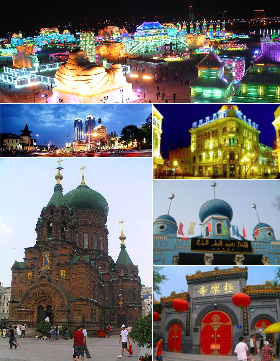
Harbin, China is about 300 miles from the Russian border in Heilongjiang province and is is the capital and largest city of Heilongjiang Province in Northeast China, as well as the tenth most populated city in the People's Republic of China. According to the 2010 China census data, the city's urban area has 5,878,939 inhabitants, while the total population of the sub-provincial city is up to 10,635,971. Harbin serves as a key political, economic, scientific, cultural and communications hub in Northeast China.

Before the Cultural Revolution there were several Russian Orthodox churches in Harbin but today only one survives - Saint Sophia Cathedral. As of 1997 the cathedral was turned into the Municipal Architecture and Art Museum (Harbin Architectural Art Gallery), showcasing the multi-cultural architectural developments of Harbin throughout the ages.
The average snowfall is around 5 inches but the average winter
daytime high is 8 F with an overnight low around -18 F and the air is very dry.
Cold temperatures start in November and it really doesn't start to warm up
until April. The Songhua River freezes
to a depth of 40 inches which is a good thing as this is where the ice blocks
are cut to build the ice sculptures and moved by trucks to the Ice and Snow World festival site. The ice
sculpture building begins in mid-December and they go on display to the public early
January until late February depending on weather conditions. The best time to view the sculptures is in the
evening when they are illuminated from within with multi-colored lights. It is
like looking at fairy tale castles in a deep freeze.

Everyone is dressed for the extreme cold and taking pictures requires some finesse to keep your fingers and the camera battery from freezing. By the end of our one hour tour in the evening our chins were numb but our down parkas, double wool pants, ski gloves, double ski socks, long johns, and ski hat kept us toasty.


BTW one of the local favorite treats sold during the winter is popsicles.
The next morning we dressed again in our layers and ventured out to see the snow sculptures at Sun Island and the Siberian tigers at the Siberia Tiger Park.
Here in Harbin I was surprised to learn that the local beer, Harbin beer, through Anheuser-Busch is a sponsor of the NBA. Yes American basketball. The brewery is owned by Anheuser–Busch InBev, which has helped to export Harbin beer to European and North American markets, but in comparison to Tsingtao Beer or Zhujiang Beer its share in these markets is minor. Shaq is their main spokesperson. But then you may already know this if you watch TV which I don't. This was a promotion campaign for the 2013 Chinese Lunar New Year celebration.




















No comments:
Post a Comment